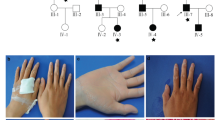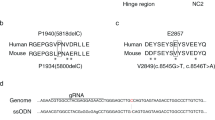Abstract
Hailey-Hailey disease (HHD, MIM 16960) is inherited in an autosomal dominant manner and characterized by persistent blisters and erosions of the skin1. Impaired intercellular adhesion and epidermal blistering also occur in individuals with pemphigus (which is due to autoantibodies directed against desmosomal proteins) and in patients with Darier disease (DD, MIM 124200), which is caused by mutations in a gene encoding a sarco/endoplasmic reticulum (ER)-Golgi calcium pump2. We report here the identification of mutations in ATP2C1, encoding the human homologue of an ATP-powered pump that sequesters calcium into the Golgi in yeast, in 21 HHD kindreds. Regulation of cytoplasmic calcium is impaired in cultured keratinocytes from HHD patients, and the normal epidermal calcium gradient is attenuated in vivo in HHD patients. Our findings not only provide an understanding of the molecular basis of HHD, but also underscore the importance of calcium control to the functioning of stratified squamous epithelia.
This is a preview of subscription content, access via your institution
Access options
Subscribe to this journal
Receive 12 print issues and online access
$209.00 per year
only $17.42 per issue
Buy this article
- Purchase on Springer Link
- Instant access to full article PDF
Prices may be subject to local taxes which are calculated during checkout





Similar content being viewed by others
References
Burge, S.M. Hailey-Hailey disease: the clinical features, response to treatment and prognosis . Br. J. Dermatol. 126, 275– 282 (1992).
Sakuntabhai, A. et al. Mutations in ATP2A2, encoding a Ca2+pump, cause Darier disease. Nature Genet. 21, 271–277 (1999).
Ikeda, S. et al. Localization of the gene whose mutations underlie Hailey-Hailey disease to chromosome 3q. Hum. Mol. Genet. 3, 1147–1150 (1994).
Peluso, A.M. et al. Narrowing of the Hailey-Hailey disease gene region on chromosome 3q and identification of one kindred with a deletion in this region. Genomics 30, 77–80 ( 1995).
Richard, G. et al. Hailey-Hailey disease maps to a 5 cM interval on chromosome 3q21–q24. J. Invest. Dermatol. 105, 357–360 (1995).
Gunteski-Hamblin, A.M., Greeb, J. & Shull, G.E. A novel Ca2+ pump expressed in brain, kidney, and stomach is encoded by an alternative transcript of the slow-twitch muscle sarcoplasmic reticulum Ca-ATPase gene. Identification of cDNAs encoding Ca2+ and other cation-transporting ATPases using an oligonucleotide probe derived from the ATP-binding site. J. Biol. Chem. 263, 15032–15040 (1988).
Gunteski-Hamblin, A.M., Clarke, D.M. & Shull, G.E. Molecular cloning and tissue distribution of alternatively spliced mRNAs encoding possible mammalian homologues of the yeast secretory pathway calcium pump. Biochemistry 31, 7600 –7608 (1992).
Rudolph, H.K. et al. The yeast secretory pathway is perturbed by mutations in PMR1, a member of a Ca2+ ATPase family. Cell 58, 133–145 (1989).
Antebi, A. & Fink, G. The yeast Ca(2+)-ATPase homologue, PMR1, is required for normal Golgi function and localizes in a novel Golgi-like distribution. Mol. Biol. Cell 3, 633–654 (1992).
Sorin, A., Rosas, G. & Rao, R. PMR1, a Ca2+-ATPase in yeast Golgi, has properties distinct from sarco/endoplasmic reticulum and plasma membrane calcium pumps. J. Biol. Chem. 272, 9895–9901 (1997).
Ikeda, S. & Ogawa, H. Effects of steroid, retinoid, and protease inhibitors on the formation of acantholysis induced in organ culture of skins from patients with benign familial chronic pemphigus. J. Invest. Dermatol. 97, 644–648 (1991).
Krizaj, D. & Copenhagen, D.R. Compartmentalization of calcium extrusion mechanisms in the outer and inner segments of photoreceptors. Neuron 21, 249–256 ( 1998).
Mauro, T., Dixon, D.B., Komuves, L., Hanley, K. & Pappone, P.A. Keratinocyte K+channels mediate Ca2+-induced differentiation. J. Invest. Dermatol. 108, 864–870 (1997).
Mauro, T. et al. Acute barrier perturbation abolishes the Ca2+ and K+ gradients in urine epidermis: quantitative measurement using PIXE. J. Invest. Dermatol. 111, 1198 –1201 (1998).
Elias, P.M. et al. Formation of the epidermal calcium gradient coincides with key milestones of barrier ontogenesis in the rodent. J. Invest. Dermatol. 110, 399–404 ( 1998).
Resing, K.A., al-Alawi, N., Blomquist, C., Fleckman, P. & Dale, B.A. Independent regulation of two cytoplasmic processing stages of the intermediate filament-associated protein filaggrin and role of Ca2+ in the second stage. J. Biol. Chem. 268, 25139–25145 ( 1993).
Chakravarthy, B., Isaacs, R., Morley, P., Durkin, J. & Whitfield, J. Stimulation of protein kinase C during Ca2+ induced keratinocyte differentiation. J. Biol. Chem. 270, 1362–1368 (1995).
Amar, L.S., Shabana, A.H., Oboeuf, M., Martin, N. & Forest, N. Involvement of desmoplakin phosphorylation in the regulation of desmosomes by protein kinase C, in HeLa cells. Cell Adhes. Commun. 7, 125–138 (1999).
Berth-Jones, J., Smith, S. & Graham-Brown, R. Benign familial chronic pemphigus (Hailey-Hailey disease) responds to cyclosporin. Clin. Exp. Dermatol. 20, 70–72 (1994).
Oda, K. Calcium depletion blocks proteolytic cleavages of plasma protein precursors which occur at the Golgi and/or trans-Golgi network. Possible involvement of Ca(2+)-dependent Golgi endoproteases. J. Biol. Chem. 267, 17465–17471 (1992).
Kaufman, R., Swaroop, M. & Murtha-Riel, P. Depletion of manganese within the secretory pathway inhibits O-linked glycosylation in mammalian cells. Biochemistry 33, 9813–9819 ( 1994).
Amagai, M., Ishii, K., Takayanagi, A., Nishikawa, T. & Shimizu, N. Transport to endoplasmic reticulum by signal peptide, but not proteolytic processing, is required for formation of conformational epitopes of pemphigus vulgaris antigen (Dsg3). J. Invest. Dermatol. 107, 539–542 (1996).
Vulpe, C. & Packman, S. Cellular copper transport. Annu. Rev. Nutr. 15, 293–322 (1995).
Riley, J. et al. A novel, rapid method for the isolation of terminal sequences from yeast artificial chromosome (YAC) clones. Nucleic Acids Res. 18, 2887–2890 ( 1990).
Aszterbaum, M. et al. Identification of mutations in the human PATCHED gene in sporadic basal cell carcinomas and in patients with basal cell nevus syndrome. J. Invest. Dermatol. 110, 885–888 (1998).
Christiano, A. et al. Strategy for identification of seqence variants in COL7a1, and a novel 2-bp deletion mutation in recessive dystrophic epidermolysis bullosa . Hum. Mutat. 10, 408–414 (1997).
Bunse, T., Steigleder, G.K., Hofert, M. & Gonsior, B. PIXE analysis in uninvolved skin of atopic patients and aged skin. Acta Derm. Venereol. 71, 287–290 (1991).
Acknowledgements
We thank patients and family members for participation; H. Baden and other referring clinicians; C. Collins, P. O'Donnell, K. Gardiner, J. Korenberg and G. Magrane for physical mapping advice and assistance; C. Carlson and D. Cox for assistance in establishing the somatic cell hybrids; D. Crumrine and S. Pennypacker for cell culture and technical assistance; B. Grant and J. Kropp for advice and equipment for TaqMan assays; M. Amagai, L. Diaz, G. Guidice, A. Haake, C. Loomis, S. Rosen, T. Sun and J. Xie for advice and assistance and for the provision of reagents; C. Botka at SACs at UCSF for computer assistance; and M. Aszterbaum, D. Copenhagen and D. Geyer Hagen for helpful discussion and assistance. Z.H. was partly supported by a SmithKline-Beecham Fellowship of the Dermatology Foundation. This work was supported by NIH AR43119 (E.H.E.) and AR44341 (T.M.), the Medical Research Service, San Francisco Veteran's Affairs and the US Department of Energy by Lawrence Livermore National Laboratory under contract W-7405-ENG-48 (G.B.).
Author information
Authors and Affiliations
Corresponding authors
Rights and permissions
About this article
Cite this article
Hu, Z., Bonifas, J., Beech, J. et al. Mutations in ATP2C1, encoding a calcium pump, cause Hailey-Hailey disease. Nat Genet 24, 61–65 (2000). https://doi.org/10.1038/71701
Received:
Accepted:
Issue Date:
DOI: https://doi.org/10.1038/71701
This article is cited by
-
Two sporadic cases of childhood-onset Hailey-Hailey disease with superimposed mosaicism
European Journal of Human Genetics (2023)
-
A computational model of the epidermis with the deformable dermis and its application to skin diseases
Scientific Reports (2021)
-
Hailey–Hailey Disease: An Update Review with a Focus on Treatment Data
American Journal of Clinical Dermatology (2020)
-
Characterization of Hailey-Hailey Disease-mutants in presence and absence of wild type SPCA1 using Saccharomyces cerevisiae as model organism
Scientific Reports (2019)
-
A putative calcium-ATPase of the secretory pathway family may regulate calcium/manganese levels in the Golgi apparatus of Entamoeba histolytica
Parasitology Research (2018)



